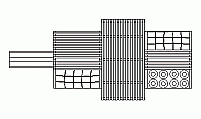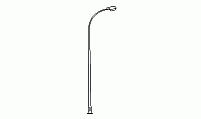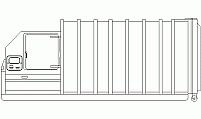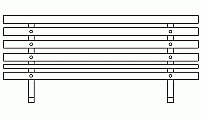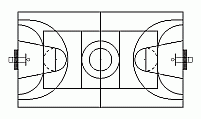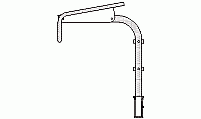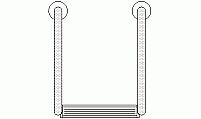CAD Blocks categories
 3D models
3D models home furniture
home furniture sanitary ware - bathrooms
sanitary ware - bathrooms professional equipment
professional equipment doors and windows
doors and windows people and animals
people and animals plants and trees
plants and trees vehicles - transports
vehicles - transports architectural details
architectural details mechanical - electrical
mechanical - electrical urban planning - civil works
urban planning - civil works safety health construction
safety health construction accessible design
accessible design drawing sheet
drawing sheet signals
signals construction machinery
construction machinery accessories and objects
accessories and objects maps and street maps
maps and street maps
Pedestrian Traffic Light CAD Block with Detailed Specifications

size: 7 kb
category: street furniture
related categories:
description: This CAD block illustrates a front-facing pedestrian traffic light with two signal sections, each displaying a standing figure, designed for urban crosswalks.
file extension: .dwg CAD - AutoCAD software
In-Depth Analysis of Design, Materials, and Compliance for Pedestrian Traffic Lights
Features of Pedestrian Traffic Lights
Pedestrian traffic lights are essential elements for ensuring safety at crosswalks and promoting orderly movement in urban areas. These lights are designed with a front-facing configuration, offering two signal sections that display universal symbols like the "standing person," which indicates when pedestrians should wait. The use of LED technology enhances visibility, providing bright, clear signals even in poor lighting conditions, while also improving energy efficiency and reducing maintenance needs. This makes them highly reliable for modern traffic systems.
The compact and minimalistic design allows for seamless integration into a wide range of urban environments. The modular structure ensures that components can be easily replaced or upgraded, minimizing downtime during maintenance. By adhering to international standards, pedestrian traffic lights ensure compatibility and consistency across different cities and regions, making them universally accessible and practical for pedestrian safety. Their robust construction also ensures long-term performance in busy and high-traffic areas.
Dimensions and Specifications
The standard dimensions for pedestrian traffic lights are carefully designed to maximize visibility and efficiency. Each signal module typically measures 12 inches by 12 inches (305 mm x 305 mm), with the full assembly standing approximately 24 inches (610 mm) tall. The housing depth ranges between 4 to 6 inches (102 mm to 152 mm), ensuring a low-profile structure that does not obstruct pedestrian pathways. These proportions are ideal for ensuring visibility across varying distances and urban layouts.
The mounting height for these signals is standardized between 7 to 10 feet (2.1 to 3 meters), ensuring accessibility for all pedestrians, including those with disabilities. The compact size makes these signals highly versatile, allowing them to be installed in narrow crosswalks or areas with dense traffic flow. Compliance with international standards guarantees compatibility with existing traffic control systems, ensuring that the lights meet the demands of modern urban planning while maintaining safety as a priority.
Materials and Durability
Pedestrian traffic lights are constructed using high-quality materials to ensure their durability and functionality. The housing is typically made from powder-coated aluminum or polycarbonate, both of which are resistant to corrosion, impacts, and harsh environmental conditions. The signal lenses are crafted from UV-resistant polycarbonate, preventing discoloration caused by prolonged exposure to sunlight and maintaining clarity for clear signal communication over time.
The use of LED technology ensures energy efficiency and long operational lifespans, often exceeding 100,000 hours. This reduces maintenance frequency, saving costs and improving reliability. Modular components further enhance the ease of maintenance, as damaged or outdated parts can be quickly replaced without extensive downtime. These materials and features make pedestrian traffic lights highly resilient and ideal for deployment in both urban and rural environments, ensuring continuous operation under diverse conditions.
Compliance with Safety Standards
Pedestrian traffic lights comply with strict safety standards to ensure reliability and performance in urban environments. In the United States, these signals meet the specifications outlined in the Manual on Uniform Traffic Control Devices (MUTCD). Similarly, European signals align with the EN 12368 standard, which governs luminance, durability, and performance requirements for traffic lights. These standards ensure that pedestrian signals are safe and effective under all conditions.
Additional features such as anti-glare visors improve visibility by minimizing sunlight interference, while the use of standardized colors and symbols ensures universal comprehension. Regular inspections and maintenance of the signals are required to ensure continued compliance with safety regulations, including the functionality of LEDs and the structural integrity of the housing. These measures are essential for maintaining safety and efficiency in high-traffic urban areas.
Frequently Asked Questions
- What materials are used in pedestrian traffic lights?
- Housings are typically made from powder-coated aluminum or polycarbonate, while the lenses are crafted from UV-resistant polycarbonate. These materials ensure long-term durability and consistent performance in diverse environments.
- What are the standard dimensions of these signals?
- Each signal section measures 12 inches by 12 inches (305 mm x 305 mm), with a total height of approximately 24 inches (610 mm). Their compact design ensures visibility while fitting seamlessly into urban areas.
- How do these signals remain visible in sunlight?
- Anti-glare visors and high-intensity LEDs are used to minimize sunlight interference, ensuring clear visibility. The visors are made from UV-resistant materials to maintain their effectiveness over time.
- What maintenance do pedestrian traffic lights require?
- Maintenance includes cleaning lenses, inspecting LEDs for functionality, and ensuring the housing remains intact. Modular components allow for quick repairs, reducing downtime and ensuring reliable operation.
- How do these signals comply with safety standards?
- Pedestrian traffic lights adhere to standards such as MUTCD in the USA and EN 12368 in Europe. These regulations govern visibility, durability, and safety, ensuring reliable performance across diverse regions.











